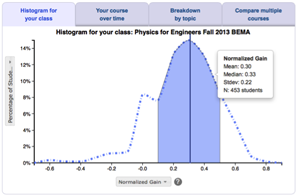Developed by Pablo Barniol and Genaro Zavala
| Purpose | To assess students’ understanding of vector concepts in problems without a physical context. |
|---|---|
| Format | Pre/post, Multiple-choice |
| Duration | 35 min |
| Focus | Mathematics Content knowledge (magnitude, direction, components, unit vector, addition, subtraction, multiplication, dot and cross product) |
| Level | Intro college |
Sample questions from the TUV:


TUV Implementation and Troubleshooting Guide
Everything you need to know about implementing the TUV in your class.
Login or register to download the implementation guide.
more details
This is the second highest level of research validation, corresponding to at least 5 of the validation categories below.
Research Validation Summary
Based on Research Into:
- Student thinking
Studied Using:
- Student interviews
- Expert review
- Appropriate statistical analysis
Research Conducted:
- At multiple institutions
- By multiple research groups
- Peer-reviewed publication
The multiple-choice questions on the TUV were developed based on student thinking about vectors collected using open-ended questions. Students’ responses to these questions were used to create the answer choices. This initial set of questions was reviewed by experts, tested with students and revised. Statistical analyses of reliability, difficulty and discrimination were conducted and reasonable values found. The TUV has been given to about 3000 students at four institutions and results published in 3 peer-reviewed papers. There are several other peer-reviewed papers by the developers where they studied vector concepts.
References
- P. Barniol, Students' difficulties with unit vectors and scalar multiplication of a vector, presented at the Physics Education Research Conference 2011, Omaha, Nebraska, 2011.
- P. Barniol and G. Zavala, Vector Addition: Effect of the Context and Position of the Vectors, presented at the Physics Education Research Conference 2010, Portland, Oregon, 2010.
- P. Barniol and G. Zavala, Testing Students’ Understanding of Vector Concepts, presented at the Physics Education Research Conference 2013, Portland, OR, 2013.
- P. Barniol and G. Zavala, Test of understanding of vectors: A reliable multiple-choice vector concept test, Phys. Rev. ST Phys. Educ. Res. 10 (1), 010121 (2014).
- P. Barniol and G. Zavala, Investigation of Students’ Preconceptions and Difficulties with the Vector Direction Concept at a Mexican University, presented at the Physics Education Research Conference 2009, Ann Arbor, Michigan, 2009.
- G. Zavala and P. Barniol, Students’ Understanding of the Concepts of Vector Components and Vector Products, presented at the Physics Education Research Conference 2010, Portland, Oregon, 2010.
- G. Zavala and P. Barniol, A Detailed Analysis of Isomorphic Problems: The Case of Vector Problems, presented at the Physics Education Research Conference 2013, Portland, OR, 2013.
PhysPort provides translations of assessments as a service to our users, but does not endorse the accuracy or validity of translations. Assessments validated for one language and culture may not be valid for other languages and cultures.
| Language | Translator(s) | |
|---|---|---|
| Arabic | Hisham Bani-Salameh |  |
| Spanish | Pablo Barniol and Genaro Zavala |  |
If you know of a translation that we don't have yet, or if you would like to translate this assessment, please contact us!
Score the TUV on the PhysPort Data Explorer
With one click, you get a comprehensive analysis of your results. You can:
- Examine your most recent results
- Chart your progress over time
- Breakdown any assessment by question or cluster
- Compare between courses
| Typical Results |
|---|
Typical Results from Barniol and Zavala 2013: The average score among a sample of 423 students who took the test in English in a calculus-based introductory electricity and magnetism course at a large private Mexican university was 13.52 of 20 points, or 68%. |
The latest version of the TUV, released in 2014, is version 1.





